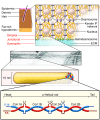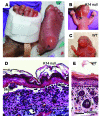Epidermolysis bullosa simplex: a paradigm for disorders of tissue fragility
- PMID: 19587453
- PMCID: PMC2701872
- DOI: 10.1172/JCI38177
Epidermolysis bullosa simplex: a paradigm for disorders of tissue fragility
Abstract
Epidermolysis bullosa (EB) simplex is a rare genetic condition typified by superficial bullous lesions that result from frictional trauma to the skin. Most cases are due to dominantly acting mutations in either keratin 14 (K14) or K5, the type I and II intermediate filament (IF) proteins tasked with forming a pancytoplasmic network of 10-nm filaments in basal keratinocytes of the epidermis and in other stratified epithelia. Defects in K5/K14 filament network architecture cause basal keratinocytes to become fragile and account for their trauma-induced rupture. Here we review how laboratory investigations centered on keratin biology have deepened our understanding of the etiology and pathophysiology of EB simplex and revealed novel avenues for its therapy.
Figures




References
-
- Garg, A., Levin, N.A., and Bernhard, J.D. 2008. Approach to dermatological diagnosis. InFitzpatrick’s dermatology in general medicine. 7th edition. K. Wolf, et al., editors. McGraw-Hill. New York, New York, USA. 23–39.
-
- Fine J.D., et al. Revised classification system for inherited epidermolysis bullosa: report of the Second International Consensus Meeting on diagnosis and classification of epidermolysis bullosa. . J. Am. Acad. Dermatol. 2000;42:1051–1066. - PubMed
-
- Marinkovich, M.P., and Bauer, E.A. 2008. Inherited epidermolysis bullosa. InFitzpatrick’s dermatology in general medicine. 7th edition. K. Wolf, et al., editors. McGraw-Hill. New York, New York, USA. 505–516.
-
- Cooper, T.W., Bauer, E.A., and Briggaman, R.A. 1987. The mechanobullous diseases (epidermolysis bullosa). InFitzpatrick’s dermatology in general medicine. 3rd edition. T.B. Fitzpatrick, et al., editors. McGraw-Hill. New York, New York, USA. 610–626.
-
- Coulombe P.A., Fuchs E. Epidermolysis bullosa simplex. Semin. Dermatol. 1993;12:173–190. - PubMed
Publication types
MeSH terms
Substances
Grants and funding
LinkOut - more resources
Full Text Sources
Other Literature Sources
Medical
Research Materials
Miscellaneous

